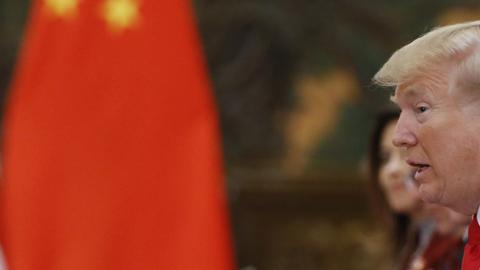Two books written by President Trump in 2000 and 2015 help to explain why he has been remarkably secretive about the instructions that he gave to two Cabinet members and his three closest White House economic advisors for two days of talks in Beijing. The secrecy has succeeded and may have resulted in an initial Trump victory Friday, without provoking a widely dreaded “trade war.”
The two biggest reasons for the secrecy are not so secret: Clearly, President Trump does not want his Chinese counterpart, President Xi, to lose face because he needs Xi’s help now more than ever as the final phases of the North Korean summit are negotiated. China can help close the deal on the date, the place and the initial terms to which North Korea's chairman, Kim Jong-un, must agree. So, this is the worst time for an open split between the U.S. and China over trade friction. The president wisely calculated that a joint, seamless China-America approach now will add to the impact of his "maximum pressure" sanctions on North Korea that are approaching a near-total blockade in effectiveness.
The other reason for secrecy — a much bigger one — is to tactfully play down the boldness of President Trump’s demands for dramatic Chinese concessions that will painfully challenge all the core elements of China’s economic system and its links to the constitution of the Communist Party. If you consider the reverse image, it’s like a Chinese delegation of cabinet secretaries arriving in Washington and giving the U.S. two years to amend our Constitution and to give up our free-market economy.
This is not a new idea that his advisers recently pushed on him; President Trump’s ideas about China date back nearly two decades.
Trump’s concern with China dates back to a book he published in 2000 that stated, “in the long term China is our biggest challenge.” He returned to this theme in another book he published in 2015 called “Crippled America,” where he argued that, “As a matter of global American global policy, we want to take away China’s advantages.” He then laid out how to persuade China to do that: “When dealing with China, we need to tell them its bad business to take advantage of your best customer.”
Unfortunately, someone in the president’s delegation or the Chinese side has revealed to American reporters in Beijing what some of the president’s negotiating demands were. Still, the leak may have ensured in the long run that the talks have succeeded by educating the Chinese about exactly what President Trump wants.
China confined its public view to one restrained, curt comment that “big differences” remained as the U.S. government delegation headed out of town a few hours later.
The leaked American demands included fundamental revisions in how the Chinese leadership manages foreign trade and its economy, including purchasing vastly more American exports in order to reduce at least $200 billion from the total U.S. trade deficit with China by 2020.
Some of the Chinese negotiators’ demands were also leaked — namely, a demand that, at the World Trade Organization in Geneva, the U.S. drop its legal complaint over China’s licensing terms for foreign patent holders and immediately designate China a market economy, among a total of “eight points.”
The U.S. team publicly relied on a White House statement today that called the talks “frank.”
The White House deliberately referred to a “consensus” among the Americans, which contradicts many Chinese articles in the past week that mocked the friction among Peter Navarro, Larry Kudlow, Treasury Secretary Steven Mnuchin, Commerce Secretary Wilbur Ross and U.S. Trade Representative Robert Lighthizer. Shrewdly, the White House added: “There is consensus within the administration that immediate action is needed to bring changes to the United States-China trade and investment relationship.”
One Chinese joked with me today that this statement obfuscates fierce divisions that China knows exist within the U.S. team, between hard-liners and free-trade advocates. “They fight more with themselves than with China,” he laughed.
The U.S. briefing paper that at first leaked on the social-media site Weibo was deleted by Chinese government censors.
The U.S. side apparently demanded that China:
1.) drop its tariffs to match lower U.S. levels;
2.) eliminate limits on U.S. investment in specific industries;
3.) end cyberattacks on U.S. targets;
4.) strengthen intellectual property safeguards, and
5.) halt subsidies for advanced technology industries.
Sticking to President Trump’s script, Treasury Secretary Steven Mnuchin correctly accentuated the positive when he told reporters that the two sides were having “very good conversations,” according to Reuters.
President Trump’s two books, in 2000 and 2015, warned that China is a tough negotiator, so it presumably was no surprise for the president to learn today that the talks had ended without any deal.
“The two sides fully exchanged views on expanding U.S. exports to China, bilateral trade in services, two-way investment, protection of intellectual property rights, resolution of tariffs and non-tariff measures, and reached consensus in some areas,” the Chinese government news agency Xinhua reported. “The two sides recognized that there are still big differences on some issues and that they need to continue to step up their work and make more progress.”
Xinhua reported that both sides agreed to establish a “working mechanism” to maintain close communication on the issues discussed in the talks.
The document supplied by the American delegation to the Chinese side ahead of the talks, which leaked to Weibo, demanded that Beijing cut the $375 billion U.S. trade deficit by $100 billion over the next 12 months and by another $100 billion by the end of 2020, by buying large, new imports from the United States.
The document demanded that China immediately “cease providing market-distorting subsidies and other types of government support that can contribute to the creation or maintenance of excess capacity in the industries targeted by the Made in China 2025 industrial plan.”
And the leaked document asked China to ensure that American investors are “afforded fair, effective and nondiscriminatory market access and treatment,” adding that China must reduce “tariffs on all products in noncritical sectors to levels that are no higher than the levels of the United States’ corresponding tariffs.”

















